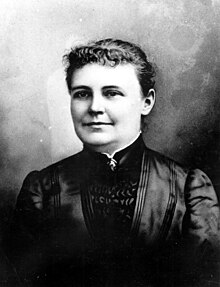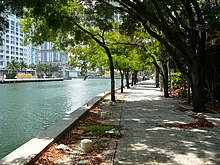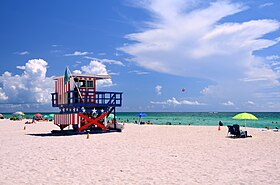
A | B | C | D | E | F | G | H | CH | I | J | K | L | M | N | O | P | Q | R | S | T | U | V | W | X | Y | Z | 0 | 1 | 2 | 3 | 4 | 5 | 6 | 7 | 8 | 9
Miami-Dade County | |
|---|---|
|
Left to right from top down: Downtown Miami; a lifeguard station on South Beach; Miami Design District's Palm Court; Wynwood Walls in Wynwood Art District; Ocean Drive in Miami Beach; Venetian Pool; Anhinga Trail boardwalk in Everglades National Park; Kaseya Center; and Biscayne National Park | |
| Nickname(s): "Dade County", "Dade", "Metro-Dade", "Greater Miami" | |
| Motto: Delivering Excellence Every Day | |
 | |
| Coordinates: 25°36′38″N 80°29′50″W / 25.61058°N 80.497099°W[1] | |
| Country | |
| State | |
| Region | South Florida |
| Metro area | Miami |
| Founded | January 18, 1836 |
| Named for | Francis L. Dade and Miami, derived from the Miami River, and ultimately derived from Mayaimi |
| County seat and largest city | |
| Incorporated municipalities | 34 |
| Government | |
| • Type | Two-tier federation |
| • Body | Miami-Dade Board of County Commissioners |
| • Miami-Dade Board of County Commissioners[2] | Commissioners
|
| • Mayor of Miami-Dade County | Daniella Levine Cava (D)[a] |
| Area | |
| • Total | 2,431.178 sq mi (6,296.72 km2) |
| • Land | 1,898.753 sq mi (4,917.75 km2) |
| • Water | 532.425 sq mi (1,378.97 km2) 21.9% |
| Highest elevation | 20−25 ft (6–8 m) |
| Lowest elevation | 0 ft (0 m) |
| Population | |
| • Total | 2,701,767 |
| • Estimate (2022)[5] | 2,673,837 |
| • Rank | 7th in the United States 1st in Florida |
| • Density | 1,408.21/sq mi (543.71/km2) |
| Demonym | Miami-Dadian[citation needed] |
| GDP | |
| • Total | $219.476 billion (2022) |
| Time zone | UTC−5 (Eastern Time Zone) |
| • Summer (DST) | UTC−4 (Eastern Daylight Time) |
| ZIP Codes | 33002, 33010–33018, 33030–33035, 33039, 33054, 33056, 33090, 33092, 33101–33102, 33106, 33109, 33111–33112, 33114, 33116, 33119, 33122, 33124–33147, 33149–33158, 33160–33170, 33172–33199, 33206, 33222, 33231, 33233–33234, 33238–33239, 33242–33243, 33245, 33247, 33255–33257, 33261, 33265–33266, 33269, 33280, 33283, 33296, 33299 |
| Area codes | 305, 786, 645 |
| FIPS code | 12086 |
| GNIS feature ID | 295755 |
| Primary Airport | Miami International Airport (MIA) |
| Secondary Airport | |
| Interstates | |
| U.S. Routes | |
| State Routes | |
| Rapid Transit | Metrorail |
| Commuter Rail | Amtrak, Brightline, Tri-Rail |
| Website | www |
Miami-Dade County (/maɪˈæmi ˈdeɪd/) is a county located in the southeastern part of the U.S. state of Florida. The county had a population of 2,701,767 as of the 2020 census,[4] making it the most populous county in Florida and the seventh-most populous county in the United States.[7] It is Florida's third largest county in terms of land area with 1,946 square miles (5,040 km2). The county seat is Miami, the core of the nation's ninth-largest and world's 65th-largest metropolitan area with a 2020 population of 6.138 million people, exceeding the population of 31 of the nation's 50 states as of 2022.[8]
As of 2021, Miami-Dade County has a gross domestic product of $154.9 billion, making it the 14th-largest of the nation's 3,033 counties. The county is home to the Port of Miami on Biscayne Bay, the world's largest passenger port with a world record 5.5 million passengers in 2018, and Miami International Airport, the third largest U.S. airport for international passengers and largest U.S. airport for international cargo. The county's land area of nearly 2,000 square miles exceeds that of two U.S. states, Delaware and Rhode Island.[9] The county is home to several universities and colleges, including Florida International University, one of the largest public universities in the country, and the University of Miami in Coral Gables, a private research university that is routinely ranked as one of the nation's top universities and is the county's second-largest employer with nearly 17,000 employees as of 2021.[10][11]
Miami-Dade County is heavily Hispanic and was the most populous majority-Hispanic county in the nation as of 2020. It is home to 34 incorporated cities and many unincorporated areas.[12] The northern, central and eastern portions of the county are heavily urbanized with many high-rise buildings along the coastline, including Miami's Central Business District in Downtown Miami. Southern Miami-Dade County includes the Redland and Homestead areas, which make up the agricultural economy of the county. Agricultural Redland makes up roughly one third of Miami-Dade County's inhabited land area, and is sparsely populated, a stark contrast to the densely populated, urban portions of the county’s northern sections.
The county includes portions of two national parks. To the west, the county extends into the Everglades National Park and is populated only by a Miccosukee tribal village. Biscayne National Park and the Biscayne Bay Aquatic Preserves are located east of the mainland in Biscayne Bay.[13][14]
History
Native people
The earliest evidence of Native American settlement in the Miami region is from approximately 12,000 years ago.[15] The first inhabitants settled on the banks of the Miami River, with the main villages on the northern banks.
The inhabitants at the time of first European contact were the Tequesta people, who controlled much of southeastern Florida, including present-day Miami-Dade County, Broward County, and the southern part of Palm Beach County. The Tequesta Indians fished, hunted, and gathered the fruit and roots of plants for food, but did engage in agriculture. They buried the small bones of the deceased with the rest of the body, and put the larger bones in a box for the village people to see. The Tequesta are credited with making the Miami Circle.[16]
European explorers and settlers
Juan Ponce de León was the first European to visit the area in 1513 by sailing into Biscayne Bay. His journal records he reached Chequescha, a variant of Tequesta, which was Miami's first recorded name.[17] It is unknown whether he came ashore or made contact with the natives. Pedro Menéndez de Avilés and his men made the first recorded landing when they visited the Tequesta settlement in 1566 while looking for Avilés' missing son, shipwrecked a year earlier.[18] Spanish soldiers led by Father Francisco Villarreal built a Jesuit mission at the mouth of the Miami River a year later but it was short-lived. After the Spaniards left, the Tequesta Indians were left to fend themselves from European-introduced diseases like smallpox. By 1711, the Tequesta sent a couple of local chiefs to Havana, Cuba, to ask if they could migrate there. The Cubans sent two ships to help them, but Spanish illnesses struck and most of the Tequesta died.[19]
The first permanent European settlers arrived in the early 19th century. People came from the Bahamas to South Florida and the Keys to hunt for treasure from the ships that ran aground on the treacherous Great Florida Reef. Some accepted Spanish land offers along the Miami River. At about the same time, the Seminole Indians arrived, along with a group of runaway slaves. The area was affected by the Second Seminole War, during which Major William S. Harney led several raids against the Indians. Most non-Indian residents were soldiers stationed at Fort Dallas. It was the most devastating Indian war in American history, causing almost a total loss of population in Miami.
After the Second Seminole War ended in 1842, William English re-established a plantation started by his uncle on the Miami River. He charted the "Village of Miami" on the south bank of the Miami River and sold several plots of land. In 1844, Miami became the county seat, and six years later a census reported there were ninety-six residents in the area.[20] The Third Seminole War was not as destructive as the second, but it slowed the settlement of southeast Florida. At the end of the war, a few of the soldiers stayed.
Establishment

Dade County was created on January 18, 1836, under the Territorial Act of the United States. The county was named after Major Francis L. Dade, a soldier killed in 1835 in the Second Seminole War, at what has since been named the Dade Battlefield.[21] At the time of its creation, Dade County included the land that now contains Palm Beach and Broward counties, together with the Florida Keys from Bahia Honda Key north and the land of present-day Miami-Dade County. The county seat was originally at Indian Key in the Florida Keys; then in 1844, the County seat was moved to Miami. The Florida Keys from Key Largo to Bahia Honda were returned to Monroe County in 1866. In 1888 the county seat was moved to Juno, near present-day Juno Beach, Florida, returning to Miami in 1899. In 1909, Palm Beach County was formed from the northern portion of what was Dade County, and then in 1915, Palm Beach County and Dade County contributed nearly equal portions of land to create what is now Broward County. There have been no significant boundary changes to the county since 1915.[22][23][24]
Hurricane Andrew
The third-costliest natural disaster to occur in the United States was Hurricane Andrew, which hit Miami in the early morning of Monday, August 24, 1992. It struck the southern part of the county from due east, south of Miami and very near Homestead, Kendall, and Cutler Ridge, which was later renamed Cutler Bay. Damages exceeded US$25 billion in the county, and recovery took years in these areas where the destruction was greatest. Hurricane Andrew was the costliest natural disaster in U.S. history until Hurricane Katrina struck the Gulf region in 2005.
Name change
On November 13, 1997, voters changed the name of the county from Dade County to Miami-Dade County to acknowledge the international name recognition of Miami.[25] Voters were acting pursuant to home rule powers granted to Dade County, including the ability to change the name of the county without the consent of the Florida Legislature.[26] With the name change, Miami-Dade became the only county in the United States whose name was hyphenated.
Geography

| Miami, Florida[27] | ||||||||||||||||||||||||||||||||||||||||||||||||||||||||||||
|---|---|---|---|---|---|---|---|---|---|---|---|---|---|---|---|---|---|---|---|---|---|---|---|---|---|---|---|---|---|---|---|---|---|---|---|---|---|---|---|---|---|---|---|---|---|---|---|---|---|---|---|---|---|---|---|---|---|---|---|---|
| Climate chart (explanation) | ||||||||||||||||||||||||||||||||||||||||||||||||||||||||||||
| ||||||||||||||||||||||||||||||||||||||||||||||||||||||||||||
Text je dostupný za podmienok Creative Commons Attribution/Share-Alike License 3.0 Unported; prípadne za ďalších podmienok. Podrobnejšie informácie nájdete na stránke Podmienky použitia.
Analytika
Antropológia Aplikované vedy Bibliometria Dejiny vedy Encyklopédie Filozofia vedy Forenzné vedy Humanitné vedy Knižničná veda Kryogenika Kryptológia Kulturológia Literárna veda Medzidisciplinárne oblasti Metódy kvantitatívnej analýzy Metavedy Metodika Text je dostupný za podmienok Creative
Commons Attribution/Share-Alike License 3.0 Unported; prípadne za ďalších
podmienok. www.astronomia.sk | www.biologia.sk | www.botanika.sk | www.dejiny.sk | www.economy.sk | www.elektrotechnika.sk | www.estetika.sk | www.farmakologia.sk | www.filozofia.sk | Fyzika | www.futurologia.sk | www.genetika.sk | www.chemia.sk | www.lingvistika.sk | www.politologia.sk | www.psychologia.sk | www.sexuologia.sk | www.sociologia.sk | www.veda.sk I www.zoologia.sk | ||||||||||||||||||||||||||||||||||||||||||||||||||||||||||||











